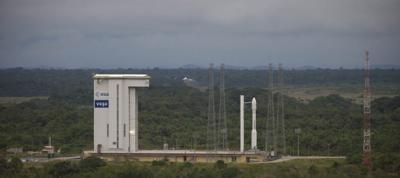Tue, Jan 31, 2012
Launch Window Opens February 9th
ESA’s new Vega rocket is now fully assembled on its launch
pad. Final preparations are in full swing for the rocket’s
inaugural flight from Europe’s Spaceport. The launch window
opens on February 9th. The upper composite, comprising LARES,
ALMASat-1, seven CubeSats, the payload adapter and the fairing, was
moved to the pad late Monday night. A night transfer is the
standard practice in Kourou to avoid overheating the payloads.

The move ended early Tuesday morning with its installation on
the dedicated stand inside the mobile gantry to await mating with
the launcher. The composite was then added on top of Vega’s
AVUM fourth stage to finalise electrical connections and verify
links, concluding with the final mechanical connection.
The main remaining steps to the maiden flight are the final
checkout of the assembled vehicle, the full launch countdown
rehearsal and the fuelling of the restartable AVUM.
This first flight, dubbed VV01, marks the end of nine years of
development by ESA and its partners, Italian space agency ASI,
French space agency CNES and industry. It will lift off from the
new Vega launch site at Europe’s Spaceport in Kourou, French
Guiana, carrying nine satellites into orbit. The launch window
opens on February 9 and ends a few days later. The mission will
qualify the overall Vega system, including the vehicle, the ground
infrastructure and operations from the launch campaign to the
payload separation and disposal of the upper module. In particular,
it will demonstrate the vehicle’s performances and payload
services in flight.
Vega will provide Europe with a safe, reliable and competitive
capacity to carry science and Earth observation satellites into
orbit, while perfectly complementing the heavy Ariane 5 and medium
Soyuz rockets already launched from the spaceport. The rocket is
designed to cope with a wide range of missions and payload
configurations in order to respond to different market
opportunities and provide great flexibility.
Unlike most small launchers, Vega is able to place multiple
payloads into orbit. In particular, it offers configurations able
to handle payloads ranging from a single satellite up to one main
satellite plus six microsatellites. It is compatible with payload
masses ranging from 660 to 5,500 pounds, depending on the type and
altitude of the orbit required by the customers. The benchmark is a
3,300 pound payload into a 435 mile-altitude polar orbit.
More News
Pilot Also Reported That Due To A Fuel Leak, The Auxiliary Fuel Tanks Were Not Used On June 4, 2025, at 13:41 eastern daylight time, a Piper PA-23, N2109P, was substantially damage>[...]
From 2023 (YouTube Edition): Reflections on War’s Collective Lessons and Cyclical Nature The exigencies of war ought be colorblind. Inane social-constructs the likes of racis>[...]
Pilot Reported That He Was Unfamiliar With The Single Seat Amateur-Built Airplane And His Intent Was To Perform High-Speed Taxi Testing Analysis: The pilot reported that he was unf>[...]
From 2023 (YouTube Edition): First Kits to Ship October 2023 Having formerly resurrected the storied shape of the Ryan ST—in effigy, anyway—Montrose, Colorado-based Tim>[...]
Performance-Based Navigation (PBN) [ICAO] Area navigation based on performance requirements for aircraft operating along an ATS route, on an instrument approach procedure or in a d>[...]
 NTSB Prelim: Piper PA-23
NTSB Prelim: Piper PA-23 Classic Aero-TV: One Mans Vietnam
Classic Aero-TV: One Mans Vietnam NTSB Final Report: Capella Aircraft Corp FW1C50
NTSB Final Report: Capella Aircraft Corp FW1C50 Classic Aero-TV: Timber Tiger Touts Curtiss Jenny Replicas
Classic Aero-TV: Timber Tiger Touts Curtiss Jenny Replicas ANN's Daily Aero-Term (07.04.25): Performance-Based Navigation (PBN) [ICAO]
ANN's Daily Aero-Term (07.04.25): Performance-Based Navigation (PBN) [ICAO]



